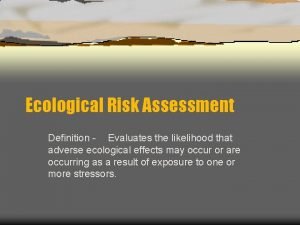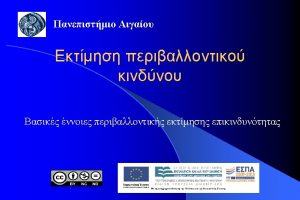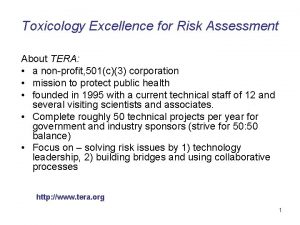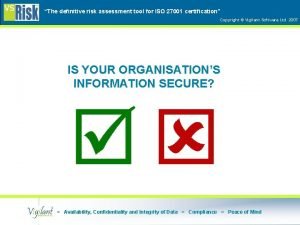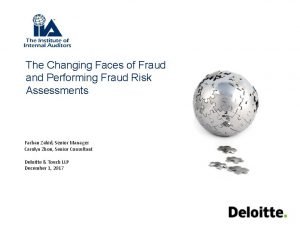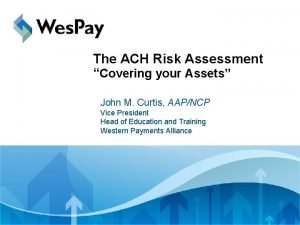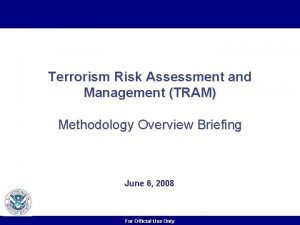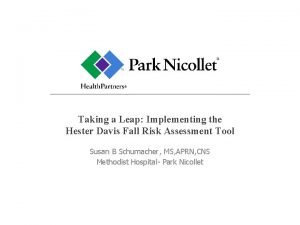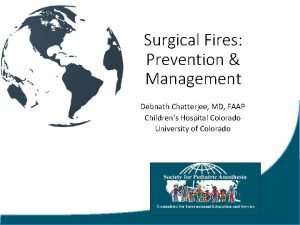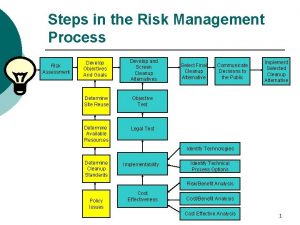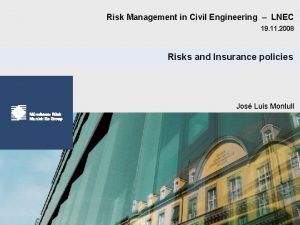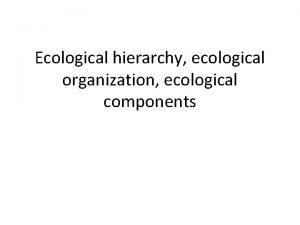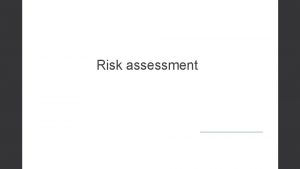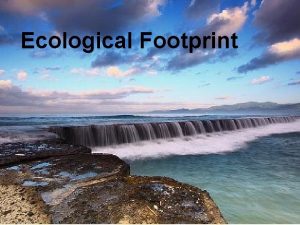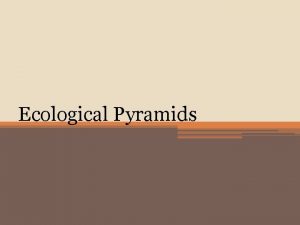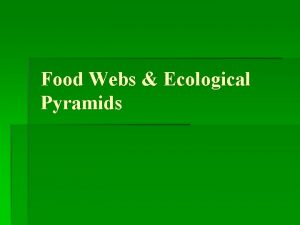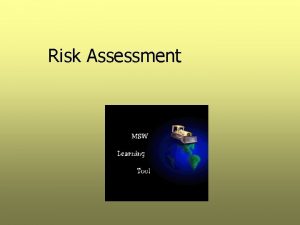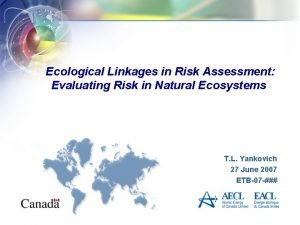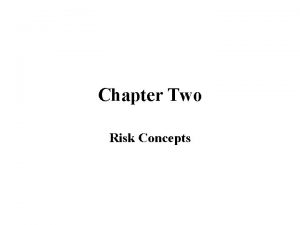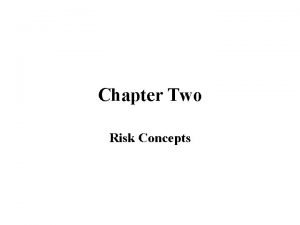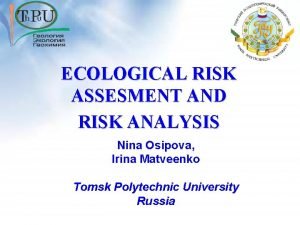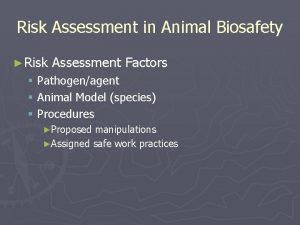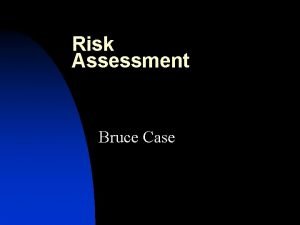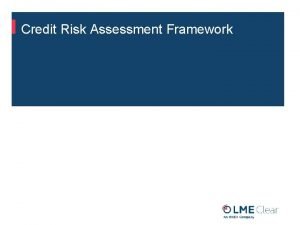A PRIMER OF ECOLOGICAL ASSESSMENT Ecological Risk Assessment




























- Slides: 28




A PRIMER OF ECOLOGICAL ASSESSMENT

Ecological Risk Assessment l l l What is ecological risk assessment? Some basic assessment concepts Ecological and Human Health assessment The ecological assessment process An ecotoxicological example: granule carbofurans.

l l A process that evaluates the probability that negative ecological effects may occur, or are presently occurring, as a result of exposure to one or more stressors or hazards The probability distribution of ecological effects is called the risk. Hazard Routes of exposure Ecological attribute Ecological effects Probability What is ecological risk assessment? Effect

l l Risk assessments explicitly evaluate the uncertainty associated with predictions about the impacts of specific human activities (“stresses”) on ecological attributes (“responses”) In decision-making, uncertainty about outcomes may be just as important as the expected “predicted” outcome! Probability Why risk assessment? Option 2 Option 1 - 0 Payoff +

Some assessment concepts I: endpoints l l l Assessment endpoint: Any ecological attribute that is either highly valued by the public, or which is demonstrably predictive of some attribute that is [valued by the public]. Measurement endpoint: any biological attribute which can be measured and which is, to some extent, predictive of the assessment endpoint. Any RA must specify the AEs, MEs, and the relationship between them. Measurement endpoints Value of AE Assessment endpoints Value of ME

Literature-derived toxicity test endpoints used for the Oak Ridge National Laboratory (ORNL) wildlife benchmarks

Endpoints and levels of biological organization l Measurement endpoints may be at the individual physiological, morphological or anatomical level, but assessment endpoints are almost invariably at population, community or ecosystem levels Physiological Morphological/ anatomical Population Community Ecosystem Measurement endpoints Assessment endpoints Both

Selection criteria for assessment endpoints l Societal relevance Ecological relevance l Unambiguous operational definition l Accessibility to prediction Susceptibility to the stressor l l

Common assessment endpoints l l l biodiversity rare, uncommon or threatened habitats fish habitat, migratory bird habitat VRTE species sensitive species important ecosystem functions

General selection criteria for measurement endpoints l l l Relevance to assessment endpoint Sensitivity and response time High signal-to-noise ratio High diagnostic ability Practical

l l Hazard: any human activity (or product thereof) that has the potential to negatively effect the assessment endpoint in question. Exposure: The extent to which an assessment endpoint co-occurs or is brought into contact with a hazard, including (1) background (E 0); (2) incremental (Ec); and (3) cumulative exposure (ET). ET E 0 [Hg] exposure Some assessment concepts II: hazards and exposure Ec Time/space

l Characterization: determining the relationship between the probability of occurrence and magnitude of an ecological effect in ecosystems of concern under different courses of action. Management: choosing among alternative courses of action based on risk characterizations, determining “acceptable” risks, and risk mitigation. Probability l Probability Assessment concepts III. Risk characterization and risk management Option 1 Option 2 Option 3 Acceptable risk Magnitude of effects

An example of hazards, policy goals, indicators and endpoints Hazard/ policy goal Assessment endpoint Indicators of effects Low level flying/no unacceptable reduction in resident large mammal populations Growth rate of black bear population in flyover area Changes in: reproductive success, overwinter mortality, and population density compared to reference area(s) Measurement endpoints No. of cubs per sow, age structure of mature adults, and spring/fall population densities compared to reference area(s)

Environmental assessment in the national regulatory context l National Environmental Policy Act (NEPA) Title 1: declares a national environmental policy and set forth procedural requirements Title 2: creates a Council on Environmental Quality (CEQ)

Environmental assessment and decision-making Risk Assessment Decision-making Risk Characterization Risk Management Mitigation & Monitoring

The general risk assessment framework l l l Problem formulation: (1) policy goals; (2) ecosystems are at risk; (3) stressor/hazard characterization; (4) endpoint selection Risk analysis: (1) exposure characterization; (2) effects characterization (stress-response relationships) Risk characterization: (1) integration of S-R and exposure characterizations; (2) uncertainty analysis Problem Formulation Risk Analysis Risk Characterization Risk Management

l Hazards ? inference Ecological effects (known) already been observed, and the role of ERA is to estimate the probability that these effects are Hazards (known) due to some specified hazard. Predictive: different ? hazard/exposure scenarios are possible, and the role of ERA is to estimate the probability prediction distribution of effects under these different scenarios. Probability l Predictive versus retrospective risk assessment Retrospective: effects have Effect

l l Various possible hazards/stressors identified, including contaminants, hydroelectric dam construction, contaminants Role of retrospective ERA was to evaluate the likelihood that the declines were caused by a particular stressor Annual sturgeon CPUE (kg/licence) What was responsible for declines in sturgeon catch on the lower Saskatchewan River? 150 The Pas 120 A Cumberland House 90 60 30 0 75 80 85 Year (1900) 90 95

Assessed risks to sturgeon in the lower Saskatchewan River Estimated risk Stressor Indigenous Major dams 16 Contaminants 8 Minor dams & dikes 5 Bird predation 2 Overexploitation 1 Scientific Uncertainty

An example: Environmental assessment of granular formulations of carbofurans l Can pesticides containing granule carbofurans be used without “causing unreasonable risk to man or the environment, taking into account the economic, social and environmental costs and benefits of the use of the pesticide”? (U. S. FIFRA, 1985)

l l l Stressors/hazards: the granular formulation of the pesticide carbofuran Indicators of effects: birds (kills involving at least 30 species had been reported) Assessment endpoint: avian survival. Measurement endpoints: mortality rates of selected species in the field, LD 50 s for laboratory studies. Application rate Mortality l Mortalities/acre Step I: problem formulation & endpoint definition 0. 7 0. 6 0. 5 0. 4 0. 3 0. 2 0. 1 0. 0 0 2 5 10 [ ] (mg AI/kg) 20

Step II: effects assessment l l l In second step, a number of lab studies designed to evaluate acute toxicity (LD 50 s) to birds were assessed. also a study of sub-acute dietary LC 50 s was evaluated. Six field studies looking at mortalities/acre from different crops receiving different amounts of carbofuran were reviewed.

Step III: exposure assessment l Estimation of numbers of granules exposed on soil surface following different application methods (band, in -furrow, broadcast) at different application rates

l l Evaluated in part by comparing estimated exposure levels with calculated LD 50 s to generate a risk value defined by Minimum and maximum risk calculated for different measurement endpoints (taxa) for different application methods, using estimated LD 50 s and exposure distributions. Probability Step IV: risk characterization Riskmin Corn (songbirds) Corn (waterfowl) Riskmax Risk (LD 50/ft 2)

Step V: determination of costs/benefits and acceptable risk (regulatory decisionmaking) l Can pesticides containing granule carbofurans be used without “causing unreasonable risk to man or the environment, taking into account the economic, social and environmental costs and benefits of the use of the pesticide”? (FIFRA, 1985) l l Riskmax for all taxa determined to be high. Benefits (in terms of increased crop value) adjudged to be positive but not large. But ecological costs deemed unacceptable, i. e. ecological costs outweigh benefits. granular formulations of carbofuran banned in U. S. A. by E. P. A. in 1989.
 Evaluates definition
Evaluates definition Liquidity measures
Liquidity measures Ecological risk assesment
Ecological risk assesment Draw rmmm plan
Draw rmmm plan Risk mitigation avoidance
Risk mitigation avoidance How to calculate relative risk
How to calculate relative risk Residual risk and secondary risk pmp
Residual risk and secondary risk pmp Ar = ir x cr x dr
Ar = ir x cr x dr Absolute risk vs relative risk
Absolute risk vs relative risk Thinking algebraically stock market game answer key
Thinking algebraically stock market game answer key Pestle risk classification system
Pestle risk classification system Pembelanjaan risiko
Pembelanjaan risiko The biggest risk is not taking any risks
The biggest risk is not taking any risks Fiduciary investment risk management association
Fiduciary investment risk management association Ir x cr x dr
Ir x cr x dr Business risk and financial risk leverage
Business risk and financial risk leverage Attributable risk
Attributable risk Risk map risk management
Risk map risk management Relative risk
Relative risk Tera toxicology
Tera toxicology Caries risk assessment form
Caries risk assessment form Iso 27001 risk assessment tools
Iso 27001 risk assessment tools Check kiting example
Check kiting example Ach risk assessment template free
Ach risk assessment template free Tram risk assessment
Tram risk assessment Hester fall risk scale
Hester fall risk scale Asa airway fire algorithm
Asa airway fire algorithm Risk assessment process
Risk assessment process Civil engineering completed risks insurance
Civil engineering completed risks insurance
